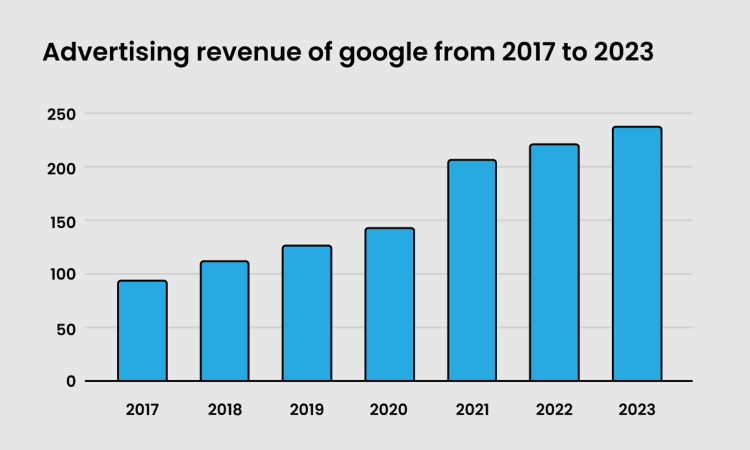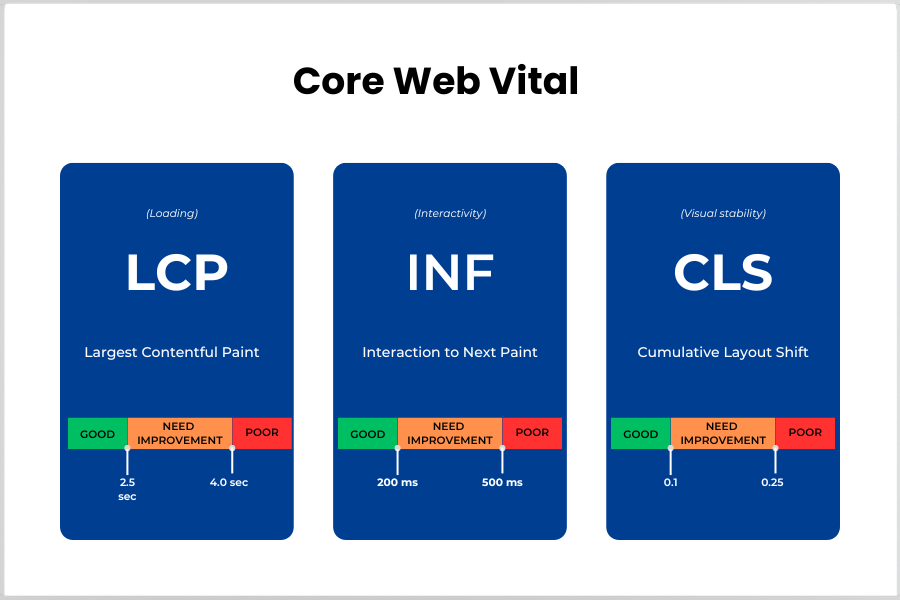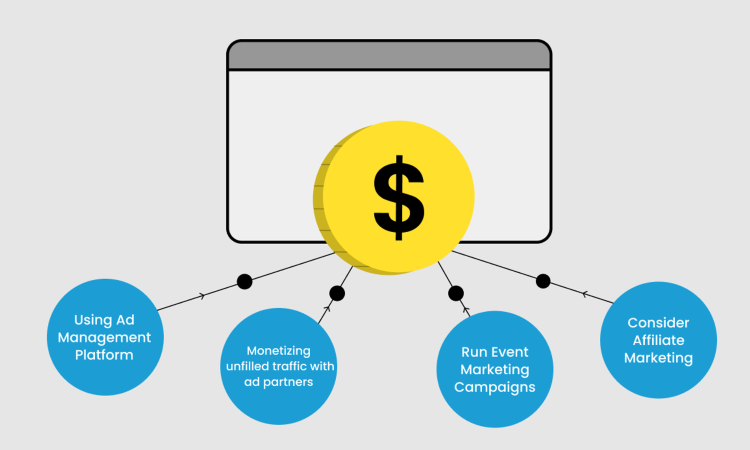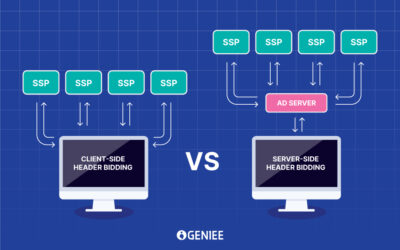
According to Statista in 2024, Google’s ad revenue amounted to 237.86 billion U.S. dollars, recorded 61.9% growth in the revenue of 2020 which is 146.92 billion U.S. dollars. The number indicated that ad revenue has the potential to grow due to the boom of smart gadgets and the internet. Taking advantage of this, publishers can maximize their ad revenue.
Let’s explore what ad revenue is and what publishers can do to improve it.

Source: Statista – Advertising revenue of Google from 2017 to 2023 (in billion U.S. dollars)
What is Ad Revenue?
Ad revenue (Advertising revenue) is the income generated by displaying advertisements on website, app, social media channels, or any other digital property. These ads promote products, services, or even other content creators, as a result, publishers earn a commission whenever someone interacts with their ads in a specific way.
Although the ad revenue comes from 2 mainstream sources, in this blog we focus only on digital advertising.
Ad revenue mainly comes from 2 main sources:
- Digital advertising: This refers to how publishers use platforms like Google AdMob, Google Ad Manager 360, etc. to monetize the digital property they own.
- Traditional advertising: Depending on advertisers’ goals, they arrange the bookings with publishers’ TV advertising, print, newspaper, etc.
How to calculate Ad revenue?
Ad revenue can be calculated by different ways, here we will explain in CPM and CPC Models.
Cost per mile (CPM) is the amount of money publishers earn for every 1,000 ad impressions. For example, if the CPM is $6.00, a publisher will earn $6.00 for every 1,000 times an ad is shown on their website or app. You need to use this formula to calculate with the CPM model:

For example, let’s say your website has 100,000 ad impressions in a month and a CPM of $6.00. Your ad revenue for that month will be:
Ad revenue = 100,000 ad impressions x $6.00 / 1,000 = $600.00
More to discover
CPM vs CPC: Which Is Your Better Choice?

Cost per click (CPC) is the amount publishers earn each time a user clicks on an ad. For example, if your website has 100 clicks in a day and a CPC of $6. Your ad revenue that day will be:
Ad revenue = 100 ad clicks x $6 CPC = $600
To conclude, we have this formula for the CPC Model:

Factors influencing Ad Revenue
Ad revenue is the lifeblood of many websites and apps. But how much publishers earn from ads isn’t just about having visitors. Dive into the key factors that influence ad revenue, from website traffic quality to ad format and competition.
Audience demographics
Having a targeted audience relevant to the ads is crucial. Engaged visitors who spend time on your site are more likely to click on ads. Therefore, clearing out nationality, interest, needs, ages, etc is needed.
Traffic volume
It is Counted based on the number of people who visit your digital property or website. The more visitors publishers have, the more impressions websites or apps can serve.
Ad placement
The places where publishers place the ads matters a lot. We divided the ad placements into 3 parts: Top, body, and bottom. Strategic placement that considers user experience can increase ad engagement and enhance ad revenue.
Ad formats
There are 4 main types of ad formats on digital channels:
- For app; banner, native, interstitial, app open, instream video, etc
- For web: Banner, native, interstitial, interactive ads, dynamic ads, etc.
Different ad formats have varying click-through rates (CTRs) and cost-per-click (CPC) values.
How to Improve Ad Revenue
In the world of online publishing, ad revenue plays a crucial role in sustaining and growing a business. Whether you’re a seasoned publisher or just starting out, maximizing ad revenue is an ongoing endeavor that requires strategic planning and continuous optimization. Here’s a comprehensive guide on how to improve ad revenue.
Increase Traffic: Expanding Your Audience Reach
At the heart of ad revenue lies traffic. The more visitors a publisher’s websites or apps attract, the more opportunities publishers have to display ads and generate income. Here are some effective strategies to boost their traffic:
Create High-Quality Content
Engaging and informative content would help you impress users and make your websites or apps become users’ top of mind when they need to find information and address their needs. This also helps you to retain high-qualified traffic.
Leverage Social Media
Social media platforms are powerful tools for driving traffic to website. Share content across social media channels, engage with the audience, and run targeted ads to expand your reach.
Optimize for Search Engines
Implement SEO (Search Engine Optimization) best practices to improve websites’ visibility in search engine results. Use relevant keywords, optimize page titles and meta descriptions, and build backlinks from reputable websites.
Speaking of SEO, let’s have a closer look at it and find out its best practices.
Practice SEO: Enhancing Search Engine Visibility
SEO plays a pivotal role in attracting organic traffic, which is essential for long-term ad revenue growth. By optimizing websites for search engines, publishers increase the chances of people finding publishers’ content when they search for related terms.
Keyword Research
Identify relevant keywords that the target audience is using to search for information related to your niche. Incorporate these keywords naturally into your content and website structure.
On-Page Optimization
Optimize your website’s on-page elements, including page titles, meta descriptions, header tags, and image alt tags, to ensure they accurately reflect your content and are relevant to search queries.
Technical SEO
Ensure your website has a sound technical foundation that search engines can easily crawl and index. This includes factors like website speed, mobile-friendliness, and structured data markup.
Optimize Content: Tailoring Ads to the Target Audience
Once publishers have attracted a steady stream of traffic, it’s time to optimize their content to ensure it aligns with the interests of the target audience and maximizes ad revenue. This will lead to higher click-through rates (CTRs) and better ad performance. Here are some content optimization strategies:
Understand Your Audience
Conduct audience research to gain insights into your visitors’ demographics, interests, and online behavior. This will help publishers tailor their content and ad placements accordingly.
Segment Your Audience
Divide the audience into segments based on shared characteristics or interests. This allows publishers to deliver personalized content and ads that resonate with each segment.
A/B Test Ad Placements
Experiment with different ad placements to determine the most effective positions for generating clicks and conversions. Use A/B testing tools to compare different layouts and placements.
Enhance User Experience: Retaining for traffic
Improving UX is a wise strategy if publishers want to retain users. Some websites and apps have confusing UX, causing users to get discouraged and switch to other websites. This results in losing traffic and reducing monthly ad revenue. Here are some ways to optimize UX:
Prioritize website speed and mobile responsiveness
If you have websites, ensure they load quickly, ideally within 5 seconds, across all devices. This will keep your audience engaged and reduce the likelihood of them bouncing away from your site.
More to discover
Core Web Vitals: How Do Ads Impact Them?

Ensuring a clean and user-friendly design
Keep your design elements well organized and use the white space. Simple navigation will make it easy for users to find the information they want instead of being frustrated by the messy dashboard. Follow a consistent style in terms of fonts, colors, and layout to avoid being jarring and making it harder to read because people usually scan-read online content.
Continuously check Ad placement and formats
Different ad placements will result in different revenue, so strike a balance between maximizing ad revenue and maintaining user experience. Publishers should avoid overwhelming users with placing too many ads. Ads shouldn’t interrupt the natural flow of content consumption, so publishers can read about different types of ad formats here to understand and choose which type of ad best suits their users. Regularly do A/B testing between ad formats and ad placements to know which option will help optimize the income source the most.
Learn your users’ demographic
In addition, analyzing data on websites and apps such as geographical location, interests, age, and behavior also helps publishers choose appropriate ads and distribute traffic to Ad networks and Ad partners appropriately. Moreover, user analysis combined with choosing a reasonable advertising format will help to determine which format and which audience will bring higher CTR (Click-through rates) without affecting the user experience.
Diversify Revenue Streams
While improving ad revenue is important, this is not the only. Publishers need to expand their revenue portfolio to create sustainable income. These are a few ways to increase their ad income:

Using Ad Management Platform
This acts as a central hub for all your ad activities, streamlining the process and maximizing your ad revenue. It can target your ad with specific demographics, online behavior leading to a high CTR and better ad performance. Some ad management platforms are Google Ad Manager 360, Amazon Advertising Platform, SmartyAds, etc.
Monetizing the unfilled traffic with ad partners
If your website or apps have many unfilled ad requests, let’s connect with ad partners to get better offers. Some ad partners have better purchasing power for certain types of apps and websites than their competitors in the same industry. Therefore, choose them carefully and continuously do A/B testing.
Running event marketing
Running event marketing campaigns on your app and website is also a smart way to optimize advertising revenue. For example, if someone has a campaign with a budget of $6000, he wants to run the campaign on your site with a awareness target in a specific period. When you say ‘yes’ to the campaign and achieve the target, you will enhance your income and make use of the unfilled traffic. However, make sure your traffic is of good quality for the campaign to achieve the best results, creating a foundation for subsequent campaigns.
Considering affiliate marketing
You can consider affiliate marketing to make the most of the traffic you have and earn more income.
Key takeaways
Together, we learned the definition of Ad revenue and listed out 4 main factors influencing the ad revenue.
Along with the definition, we found out tips to enhance your ad revenue to make your income more sustainable. These are 6 tips: increasing traffic, SEO best practices, optimizing content, enhancing UX, doing A/B testing for ad format and ad placement, and diversifying your ad revenue.
Although there are more ways to improve ad revenue, Geniee has listed the most popular way above in our blog. You can also learn case studies from to see how they grew ad revenue and learn from their mistakes. Some lessons take a lot of time to conclude and you can save time by digging deeper into them to avoid mistakes and success.
Unlock your new revenue streams. Partner with Geniee today.




0 Comments